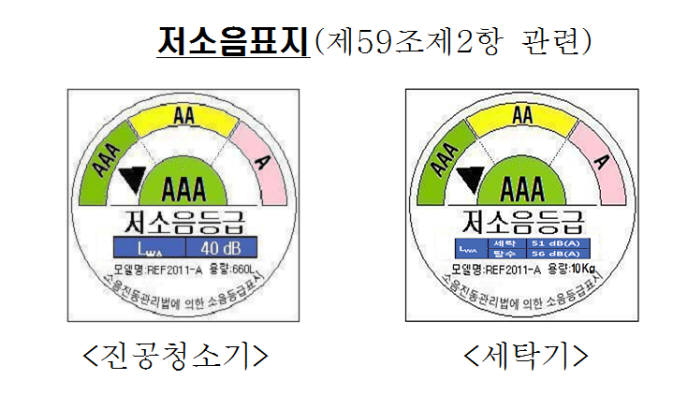It has been found that only two out of ten vacuum cleaners and washing machines sold in the market satisfy the standard of ‘low noise labeling for home appliances’ designated by the government. Low noise labeling standard had been established by the government to encourage low-noise home appliance development and was put into effect early last month. This is a non-compulsory standard and the industry can choose to practice it voluntarily. As it is in the earlier phase of implementation, there has not yet been a company or a product that autonomously obtained low noise labeling.
According to the government and the industry on the 1st, National Institute of Environmental Research (NIER) measured the noise level of 21 washing machines and 46 vacuum cleaners from key domestic and overseas home appliance makers that are sold in the market and the result indicated that only 20% of the products satisfied low noise labeling standard.

This survey was conducted targeting the products of LG Electronics, Samsung Electronics, Daewoo Electronics, Dyson and Electrolux. The noise level of 46 vacuum cleaners investigated was found to be between 65.1 and 84.7dB. As for washing machines, the noise levels were 46.0 – 65.0dB for washing and 57.1 – 80.0dB for spin-drying.
To obtain low noise labeling by satisfying the government-suggested low noise range, the noise level of vacuum cleaners must be 76dB or less and that of washing machines must be 58dB or less during washing and 63dB or less during spin drying. The labeling applicable for these noise levels is A. If the noise level is reduced by 3dB and 6dB or more, low noise labeling of AA and AAA can be obtained respectively.
To obtain an AAA label, the noise level of a vacuum cleaner must be 70dB or less and that of a washing machine must be 52dB or less during washing and 57dB or less during spin drying. However, at the noise level test, only one vacuum cleaner satisfied the AAA labeling standard. None of the washing machines tested satisfied this standard. Even the products evaluated to have a relatively lower noise level were mostly in the range of A.
Home appliances industry complains that the government’s standard is excessively high. “Although it is up to individual companies to follow the labeling system, once a competitor obtains AAA, we cannot just sit by and do nothing about it,” said an insider of a home appliance maker. “The government needs to lower the standard in the initial phase and then to increase it by stages.”
At this, the government stands fast to its position that there are no problems concerning this system as it has been established through prior consultation with the industry. The government decided to increase the labeling each time a product improves its noise level by 3dB based on the low noise certification standard for eco-friendly products that is already in enforcement as the lowest limit. 3dB is a level at which acoustic energy is halved.
“There is a home appliance maker that is developing noise suppression technology with a goal to receive AAA grade for all products it will release in the future,” said a NIER source. “The reason labeling is given as A – AAA rather than in numbers, such as of energy efficiency rating 1 – 5, is because it indicates that all products that are within the range are excellent products.”
There are voices criticizing that it is inappropriate to have set vacuum cleaner noise level assessment on carpets. They claim that the test must be carried out on wooden or linoleum flooring, which is used in most households in Korea.
“Korean Industrial Standard (KS) does not specify screening criteria for environments other than carpet,” said a Ministry of Environment source. “It is our understanding that Korean Agency for Technology and Standards followed the standard of International Standardization Organization (ISO) for assessment in carpet.”
(Glossary) Low noise labeling for home appliances
The government revised Noise and Vibration Control Act last year and put it into effect this year in order to accelerate low-noise home appliance production and distribution. The issue of inter-floor noise, which has become a social problem as of late, triggered the introduction of this system. Applied limitedly to vacuum cleaners and washing machines, it was examined of compulsory application to all products released into the market at the time of the law revision. However, according to a criticism about the system being ‘regulatory,’ low noise labeling was changed to an autonomous system. Abroad, only the EU has introduced a system similar to that of Korea.
It has been identified that only two out of ten vacuum cleaners and washing machines sold in the market can carry ‘low noise’ label. Some criticize that the standard is too strict. However, the government holds fast to the position that there is no problem with this system as it has been established for the purpose of encouraging low-noise home appliance development and is to be adopted voluntarily by the industry.